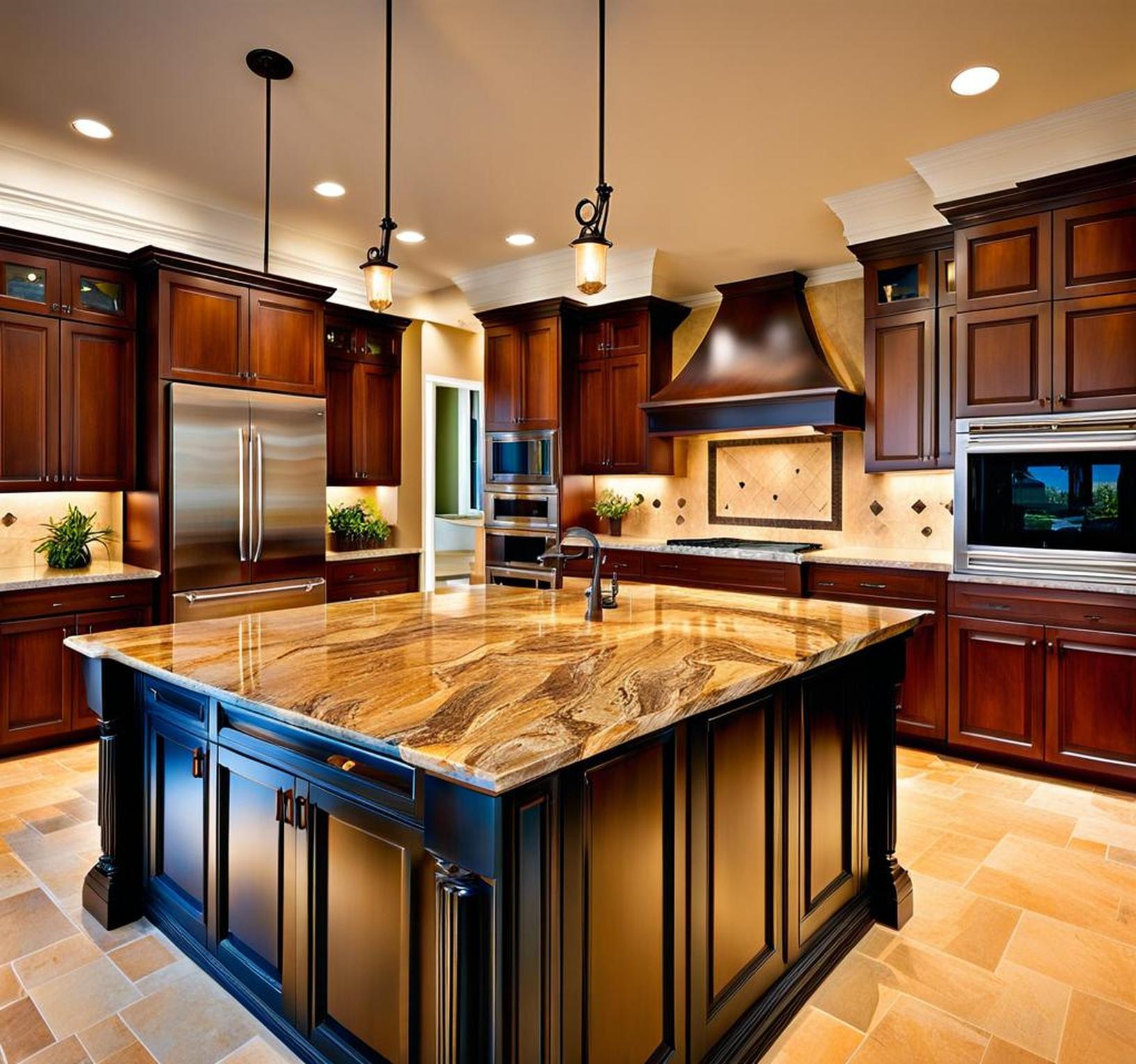Kitchen islands provide additional countertop workspace, storage, and seating. But they can be so much more – with the right design, your kitchen island can become a true focal point and statement piece. One creative way to transform your island into a showstopping centerpiece is to use contrasting countertop materials. Combining different textures, colors, and styles on your island creates visual drama that grabs attention.
Contrasting island countertops allow you to get creative and make your kitchen uniquely yours. The design flexibility enables you to mix and match an array of materials that complement each other.
Choosing Contrasting Materials
Selecting two compatible yet distinctive countertop materials is key to pulling off this look. Popular island and perimeter combinations include:
- Dark island material like black quartzite with a light perimeter surface such as white quartz or marble
- Wood island top – butcher block, reclaimed wood – with stone on the perimeter like granite or quartz
- A heavily patterned or boldly veined island surface contrasting with solid, muted perimeter countertops
When selecting materials, consider durability and stain resistance, especially around the sink area. Ease of maintenance is also important – some surfaces like quartz are nearly maintenance-free while wood requires regular sealing and conditioning.
In addition to practical factors, choose island and perimeter materials that complement each other stylistically. For example, combine cool tones with warm tones, or mix natural stone texture with sleeker modern surfaces. Contrasts work best when each material enhances the other.

Mixing Textures and Finishes
Incorporating different textures and surface finishes amplifies the contrast between island and perimeter materials. Pair a matte finish on one surface with a glossy finish on the other. Combine smooth quartz on the perimeter with a more heavily textured island top, like quartzite with visible veining or a porcelain slab with 3D texture.
Finishes with a tactile element like leathered granite, honed marble, or wood grain bring visual and textural contrast that makes the island more dynamic. For a more subtle textural contrast, use the same material like quartz but in different finishes – polished for the perimeter and matte or soft pebbled for the island.
Using Color for Dramatic Contrast
Color choice plays a major role in creating separation between the island and surrounding counters. Here are popular color combinations:
Dark Island Colors
- Black – paired with white or light gray perimeter
- Dark charcoal gray – complemented by light beige or cream
- Deep blue – accentuated by crisp white perimeter
- Rich wood tones – offset by light marble or quartz
Light Perimeter Colors
- White – makes a bold dark island pop
- Light gray – enhances drama of darker island
- Warm beige – complements cooler toned island
- Cream – accentuates wood or patterned island
Include accent colors in the backsplash tile, island pendants, stools, and elsewhere to tie the contrasting materials together. Repeating hues in various elements creates cohesion.
The Importance of a Cohesive Look
With contrasting surfaces, it’s vital to cultivate a cohesive, stylistically balanced kitchen. Maintain a consistent cabinetry style throughout for a unified foundation. Repeat design elements like hardware finishes, counter edge profiles, and decorative legs or corbels on the island and perimeter.
Lighting and backsplashes also contribute to a holistic look. Use the same fixtures and LED warmth throughout, and differentiate island backsplashes subtly with shape or material rather than color.
Transition seamlessly between the contrasting countertop materials so they meet in a clean, purposeful line. Any disconnect will look disjointed. Integrate the surfaces cohesively like two threads in a beautifully woven tapestry.
Making the Island Functionally Practical
Since islands see heavy use, select durable, low-maintenance finishes in high-traffic areas. Quartersawn wood or engineered quartzite are good wood and stone options. Laminate works well too, enabling vibrant colors and patterns while resisting scratches.
Around the sink area, choose surfaces that won’t stain easily and stand up to water and cleaning chemicals. Materials like quartz, Dekton, and Corian are impervious to moisture.
Take care to allow your distinct materials to meet seamlessly. A small overhang of the island top over the cabinetry helps disguise any thickness variations.
Factor in routine maintenance needs of your chosen materials. Surfaces like granite, marble, and wood require regular sealing to prevent staining and damage over time.
Tips for Implementation
A few additional tips to elevate your contrasting island design:
- Use a third material just for the island sink, like a stainless steel apron front sink on a granite countertop.
- Incorporate open shelving on the island in a finish that contrasts with perimeter cabinets.
- Install a tile or glass backsplash on the island that pops against a painted wall or alternate backsplash.
- Highlight the island with pendant or recessed lighting in a brushed metal or colored glass.
- Mix island and perimeter cabinet colors for even more distinction.
- Bring other kitchen elements like barstools and appliances into the contrasting design.
Implementing contrasting countertops is a creative way to transform an ordinary kitchen island into an inspiring focal point. With strategic material selection and a cohesive execution, your island can become the crowning jewel of your kitchen design.
Thoughtfully combining colors, textures, and visual styles results in a stunning, statement-making island that infuses your kitchen with drama and personality. Contrasting surfaces allow you to not only amplify the island’s presence, but also your own design sensibility.
Follow the tips provided above to craft your own vision and achieve a functionally beautiful, eye-catching contrasting island design. Use it as an opportunity to showcase your personal taste and bring your unique dream kitchen to life.
